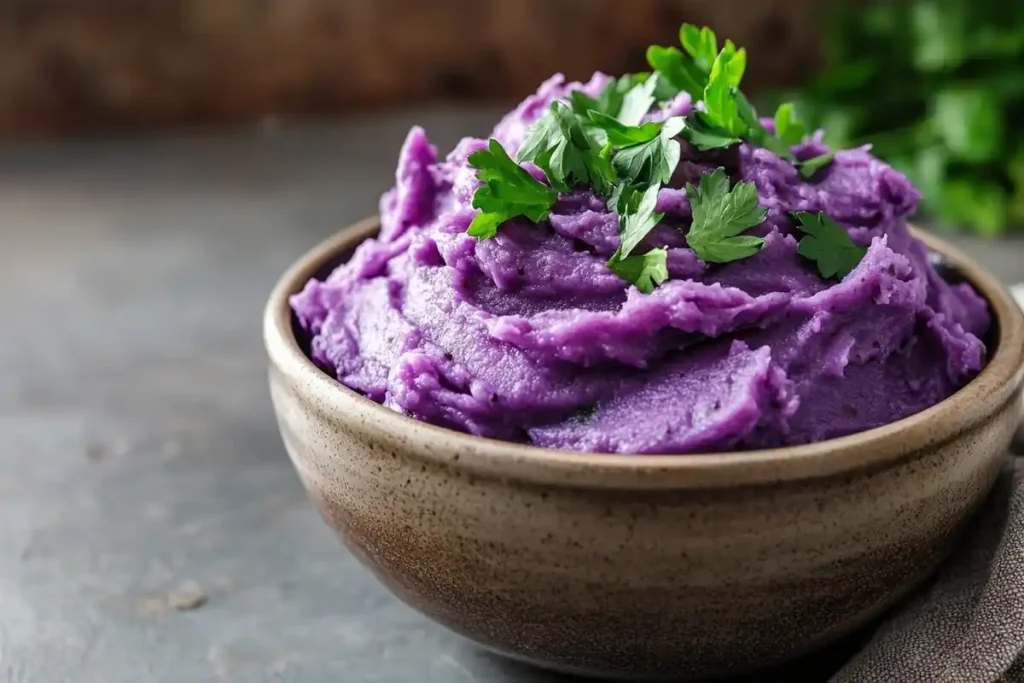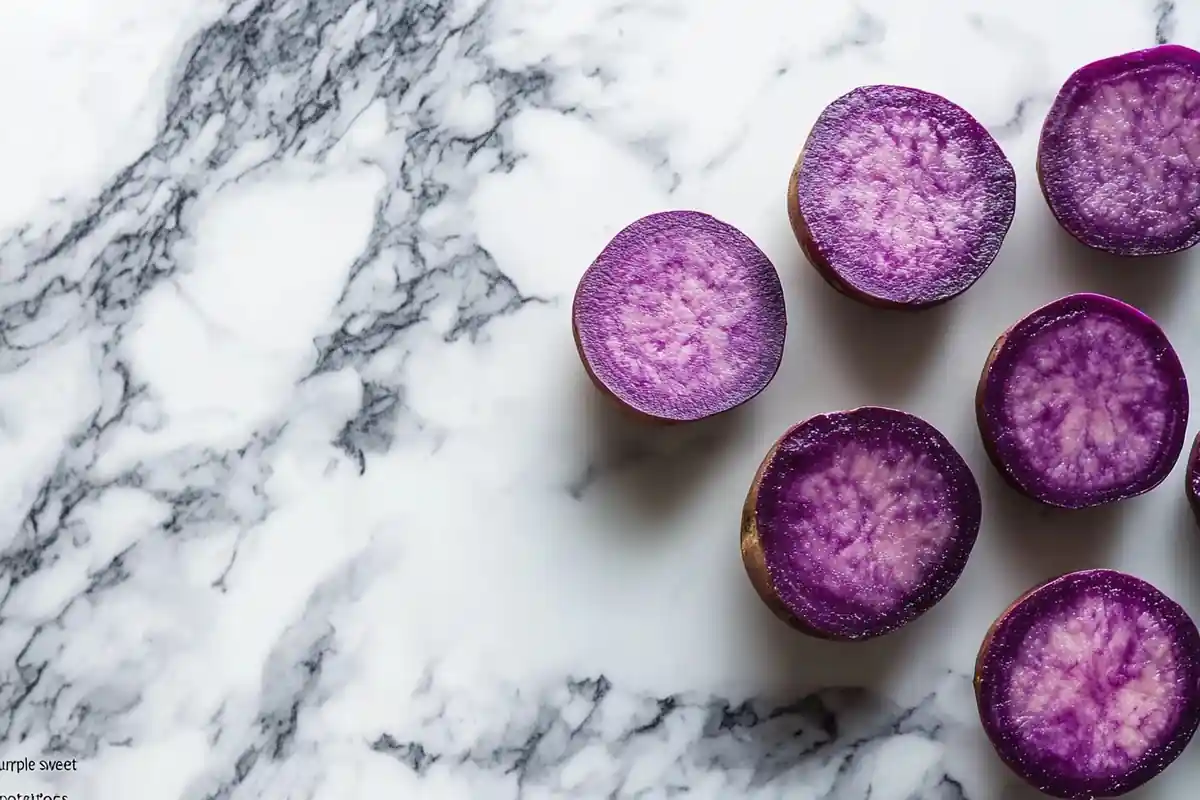Purple sweet potatoes are not only visually appealing but also packed with nutrients and health benefits. But what are purple sweet potatoes good for? This article delves into their nutritional profile, health advantages, culinary uses, and more, providing a complete guide for incorporating this vibrant vegetable into your diet.
Table of contents
- Understanding Purple Sweet Potatoes
- Health Benefits of Purple Sweet Potatoes
- Incorporating Purple Sweet Potatoes into Your Diet
- Potential Downsides
- Growing Your Own Purple Sweet Potatoes
- Purple Sweet Potatoes in Traditional Medicine
- Purple Sweet Potato vs. Other Sweet Potatoes
- Sustainable Sourcing of Purple Sweet Potatoes
- Creative Ways to Use Purple Sweet Potato Leftovers
- Conclusion
- Frequently Asked Questions (FAQs)
Understanding Purple Sweet Potatoes
What are Purple Sweet Potatoes?
Purple sweet potatoes are a variety of sweet potato distinguished by their vibrant purple flesh. Unlike orange sweet potatoes, their unique color comes from high levels of anthocyanins, a type of antioxidant also found in berries and other colorful fruits and vegetables.
Nutritional Profile
Purple sweet potatoes are rich in:
- Vitamins: Including vitamin A, vitamin C, and several B vitamins.
- Minerals: Such as potassium, manganese, and copper.
- Fiber: Important for digestive health and maintaining stable blood sugar levels.
- Antioxidants: Primarily anthocyanins, which provide numerous health benefits.
Different Varieties
There are several varieties of purple sweet potatoes, including:
- Okinawan Sweet Potato: Known for its dry, fluffy texture.
- Stokes Purple Sweet Potato: Characterized by its intense purple color and slightly sweet flavor.
- Ube Sweet Potato: Often used in desserts due to its vibrant color and sweet taste.
Health Benefits of Purple Sweet Potatoes
Rich in Antioxidants
One of the primary reasons to include purple sweet potatoes in your diet is their high antioxidant content.
- Anthocyanins: These powerful antioxidants help protect your body against damage from free radicals, reducing the risk of chronic diseases.
- Reducing Inflammation: Antioxidants in purple sweet potatoes can help lower inflammation throughout the body.
- Boosting Immune Function: By neutralizing free radicals, antioxidants support a healthy immune system.
Supporting Heart Health
Including purple sweet potatoes in your diet can have significant benefits for your heart.
- Lowering Blood Pressure: The potassium content helps regulate blood pressure levels.
- Improving Cholesterol Levels: Fiber helps reduce bad cholesterol, promoting better heart health.
- Reducing Risk of Heart Disease: The combination of antioxidants, potassium, and fiber contributes to overall cardiovascular well-being.
Enhancing Cognitive Function
The antioxidants in purple sweet potatoes may also play a role in brain health.
- Protecting Brain Cells: Antioxidants help protect brain cells from oxidative stress, which can lead to cognitive decline.
- Improving Memory: Some studies suggest that anthocyanins can enhance memory and learning.
- Reducing Risk of Neurodegenerative Diseases: Regular consumption may help lower the risk of conditions like Alzheimer’s disease.
Promoting Gut Health
Purple sweet potatoes are an excellent source of fiber, which is essential for a healthy digestive system.
- Supporting Beneficial Bacteria: Fiber feeds the good bacteria in your gut, promoting a balanced microbiome.
- Improving Digestion: Adequate fiber intake helps prevent constipation and promotes regular bowel movements.
- Reducing Risk of Colon Cancer: A healthy gut microbiome can lower the risk of colon cancer.
Managing Blood Sugar Levels
Compared to white potatoes, purple sweet potatoes have a lower glycemic index, which means they cause a slower and steadier rise in blood sugar.
- Stabilizing Blood Sugar: The fiber content further helps regulate blood sugar levels, making them a good choice for diabetics.
- Improving Insulin Sensitivity: Some studies suggest that purple sweet potatoes can improve insulin sensitivity, helping your body use insulin more effectively.
- Reducing Risk of Type 2 Diabetes: By managing blood sugar levels, they can help lower the risk of developing type 2 diabetes.
Incorporating Purple Sweet Potatoes into Your Diet
Culinary Uses
Purple sweet potatoes are incredibly versatile and can be used in a variety of dishes.
- Roasting: Roasting brings out their natural sweetness and enhances their flavor.
- Mashing: Mashed purple sweet potatoes make a colorful and nutritious side dish.
- Baking: They can be used in pies, cakes, and other baked goods.
- Grilling: Grilled slices add a unique flavor to salads and main courses.
- Steaming: Steaming preserves their nutrients and delicate flavor.
Delicious Recipes Featuring Purple Sweet Potatoes

Enjoy a healthy twist on a classic snack with roasted purple sweet potato fries.
Here are a few recipes to get you started:
- Roasted Purple Sweet Potato Fries: Cut into fries, toss with olive oil and spices, and roast until crispy.
- Purple Sweet Potato Mash: Boil or steam until tender, then mash with butter, milk, and seasonings.

A comforting and colorful side dish: creamy purple sweet potato mash.
- Purple Sweet Potato Pie: Use mashed purple sweet potatoes as a base for a vibrant and flavorful pie.
- Grilled Purple Sweet Potato Salad: Grill slices and combine with mixed greens, nuts, and a light vinaigrette.

A comforting and colorful side dish: creamy purple sweet potato mash.
Tips for Cooking with Purple Sweet Potatoes
To make the most of your purple sweet potatoes, keep these tips in mind:
- Choose Firm Potatoes: Look for potatoes that are firm and free of blemishes.
- Store Properly: Store in a cool, dark place to prolong freshness.
- Don’t Overcook: Overcooking can make them mushy.
- Experiment with Flavors: Pair with spices like cinnamon, nutmeg, and ginger.
Potential Downsides
Allergies
While rare, some individuals may be allergic to sweet potatoes.
- Symptoms: Allergic reactions can include skin rashes, itching, swelling, and digestive issues.
- What to Do: If you suspect an allergy, consult with a doctor or allergist.
Oxalates
Purple sweet potatoes contain oxalates, which can be a concern for individuals with kidney problems.
- Kidney Stones: High oxalate intake can increase the risk of kidney stone formation.
- Moderation: If you have kidney issues, consume in moderation and talk to your healthcare provider.
Growing Your Own Purple Sweet Potatoes
Choosing the Right Variety
If you have a green thumb, growing your own purple sweet potatoes can be a rewarding experience. The first step is selecting the right variety for your climate and soil conditions.
- Okinawan Sweet Potato: Thrives in warmer climates and well-drained soil.
- Stokes Purple Sweet Potato: Adaptable to various conditions but prefers full sun.
- Ube Sweet Potato: Requires a longer growing season and consistently warm temperatures.
Planting and Care Tips
Follow these tips to ensure a successful harvest:
- Start with Slips: Purchase slips (sprouts from sweet potatoes) from a reputable nursery.
- Prepare the Soil: Ensure the soil is loose, well-drained, and rich in organic matter.
- Planting Time: Plant slips after the last frost, typically in late spring or early summer.
- Watering: Keep the soil consistently moist but not waterlogged.
- Fertilizing: Use a balanced fertilizer to promote healthy growth.
- Weeding: Regularly remove weeds to prevent competition for nutrients.
Harvesting and Storage
Harvesting at the right time and storing them properly will prolong the shelf life of your purple sweet potatoes.
- Harvest Time: Harvest when the vines begin to yellow, typically in the fall.
- Dig Carefully: Use a garden fork to gently lift the potatoes from the soil.
- Curing: Cure the potatoes by placing them in a warm, humid place for about a week to heal any wounds.
- Storage: Store cured potatoes in a cool, dark, and dry place.
Purple Sweet Potatoes in Traditional Medicine
Historical Uses
Purple sweet potatoes have been used in traditional medicine for centuries.
- Asian Cultures: In many Asian cultures, they are valued for their health-promoting properties.
- Traditional Remedies: Used to treat various ailments, including inflammation, digestive issues, and skin conditions.
Modern Research
Modern research is beginning to validate some of these traditional uses.
- Anti-Inflammatory Properties: Studies have shown that the antioxidants in purple sweet potatoes can help reduce inflammation.
- Digestive Health Benefits: The fiber content supports a healthy digestive system.
- Potential Cancer Prevention: Some research suggests that anthocyanins may have anti-cancer properties.
Incorporating into Wellness Practices
Consider incorporating purple sweet potatoes into your wellness routine.
- Regular Consumption: Add them to your diet to reap their health benefits.
- Natural Remedies: Use them as part of natural remedies for specific health concerns.
- Consult with Professionals: Talk to a healthcare provider or nutritionist for personalized advice.
Purple Sweet Potato vs. Other Sweet Potatoes
Nutritional Comparison
While all sweet potatoes are nutritious, there are some key differences in their nutritional profiles.
- Antioxidant Content: Purple sweet potatoes generally have a higher antioxidant content due to their anthocyanins.
- Vitamin A: Orange sweet potatoes are particularly rich in vitamin A.
- Fiber: Both types are good sources of fiber, but the exact amount can vary.
- Glycemic Index: Purple sweet potatoes may have a slightly lower glycemic index compared to orange varieties.
Flavor and Texture Differences
The flavor and texture can also vary.
- Purple: Often have a slightly sweeter, sometimes nuttier flavor and can be drier or moister depending on the variety.
- Orange: Typically sweeter and moister than purple varieties.
- White: Less sweet and have a firmer texture.
Choosing the Right Sweet Potato
Consider your preferences and nutritional needs when choosing which type to eat.
- For Antioxidants: Choose purple sweet potatoes for their high antioxidant content.
- For Vitamin A: Opt for orange sweet potatoes to boost your vitamin A intake.
- For Versatility: All types can be used in a variety of dishes, so choose based on flavor and texture preferences.
Sustainable Sourcing of Purple Sweet Potatoes
Importance of Sustainable Practices
Choosing sustainably sourced purple sweet potatoes supports environmental health and ethical farming practices.
- Environmental Impact: Sustainable farming reduces the use of harmful pesticides and fertilizers.
- Fair Labor Practices: Ensures fair wages and safe working conditions for farmers.
- Supporting Local Farmers: Buying local supports your community and reduces transportation emissions.
How to Identify Sustainable Options
Look for these indicators:
- Organic Certification: Ensures that the potatoes were grown without synthetic pesticides or fertilizers.
- Fair Trade Certification: Guarantees fair wages and safe working conditions for farmers.
- Local Sourcing: Purchase from local farmers markets or farms.
Benefits of Supporting Sustainable Agriculture
- Healthier Environment: Reduces pollution and protects natural resources.
- Healthier Food: Minimizes exposure to harmful chemicals.
- Stronger Communities: Supports local economies and promotes social responsibility.
Creative Ways to Use Purple Sweet Potato Leftovers
Repurposing Leftovers
Avoid food waste by creatively repurposing leftover purple sweet potatoes.
- Sweet Potato Hash: Dice leftover sweet potatoes and sauté with onions, peppers, and spices for a flavorful hash.
- Sweet Potato Soup: Blend cooked sweet potatoes with broth, spices, and cream for a creamy and nutritious soup.
- Sweet Potato Pancakes: Add mashed sweet potatoes to pancake batter for a moist and flavorful twist.
- Sweet Potato Hummus: Blend cooked sweet potatoes with chickpeas, tahini, lemon juice, and spices for a unique and healthy dip.
Recipes for Leftover Purple Sweet Potatoes
Here are a few ideas:
- Purple Sweet Potato and Black Bean Tacos: Combine diced sweet potatoes with black beans, corn, and spices for a delicious taco filling.
- Sweet Potato and Coconut Curry: Add chunks of sweet potato to a coconut curry with vegetables and tofu.
- Sweet Potato and Spinach Frittata: Combine diced sweet potatoes with spinach, eggs, and cheese for a hearty frittata.
Tips for Storing Leftovers
Proper storage is key to maintaining the quality and safety of leftovers.
- Cool Quickly: Cool cooked sweet potatoes quickly before storing them.
- Store Properly: Store in an airtight container in the refrigerator.
- Use Promptly: Use leftovers within 3-4 days for best quality.
Conclusion
What are purple sweet potatoes good for? They offer a wealth of health benefits, from their high antioxidant content to their ability to support heart health, enhance cognitive function, and promote gut health. Incorporating them into your diet can be a delicious and nutritious way to improve your overall well-being. Whether roasted, mashed, baked, or grilled, purple sweet potatoes are a versatile and vibrant addition to any meal.
Frequently Asked Questions (FAQs)
All sweet potatoes are nutritious, but purple sweet potatoes are often considered particularly healthy due to their high antioxidant content, specifically anthocyanins. These compounds have been linked to various health benefits, including reducing inflammation and protecting against chronic diseases.
Purple potatoes are best for adding a vibrant color and a boost of antioxidants to your meals. They are great for roasting, mashing, salads, and even baking. Their unique color makes them a visually appealing addition to any dish.
Purple sweet potatoes generally have a slightly sweeter and sometimes nuttier flavor compared to orange sweet potatoes. The Okinawan variety can be less sweet and drier, while others like Ube have a more pronounced sweetness.
While the term “superfood” is more of a marketing term, purple potatoes certainly pack a nutritional punch. They are rich in vitamins, minerals, fiber, and antioxidants, making them a healthy addition to any diet.

